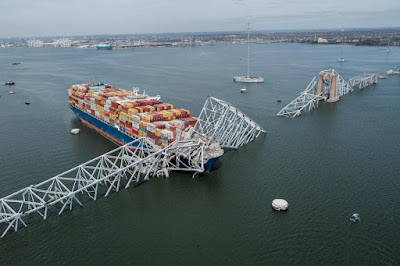As I watched the film of the container ship crash into the Francis Scott Key bridge in Baltimore Harbor yesterday, I asked myself one question.
Where are the tugs?
I served on a U.S. Navy harbor tugboat at the American nuclear submarine base at Holy Loch, Scotland in 1974-1975.
Our tug, the USS Saugus (seen in the bottom photos), escorted submarines and surface ships in and out of the Loch. We sailed alongside the ships and were prepared to push and pull the subs and ships to safety in the event that they lost navigational power.
Tugboats also perform this function in harbors around the world.
Emily Coz and Trevor Hughes at USA Today offer a piece on the Baltimore tugboats.
As investigators work to determine
what caused the hulking Dali container ship to topple Baltimore’s Francis Scott
Key bridge in a matter of seconds on Tuesday, maritime experts around the
country are pointing to what could have stopped it.
Tugboats.
These small but mighty vessels tow and push
ever-larger ships through channels and help them where their own propulsion
systems – or lack thereof – cannot. They are standard equipment in ports
worldwide and especially useful to help ships with docking and undocking.
On Tuesday, a pair of tugboats operated by
McAllister Towing and Transportation did just that, helping the Dali unmoor
itself from the main terminal at the Port of Baltimore and orient the ship
toward the open waters.
But they broke away before the massive ship
navigation under the bridge, as is common practice. Minutes later, the Dali
appeared to lose power and propulsion, sending the craft adrift and directly
into one of the bridge’s support columns. The steel-truss bridge immediately
collapsed into the frigid Patapsco River.
The accident is igniting debate over the
proliferation of “megaships” that fuel today’s commercial transportation
industry and whether port protocols have ramped up to safely accommodate them.
Although the Dali is average-sized compared to many of these behemoths, the
devastation it caused in Baltimore was formidable.
Had the tugboats
accompanied the ship all the way under the bridge, some experts said, they
might have been able to stop, slow or steer it away from danger.
Such a scenario should be standard operating
procedure in all ports, said Capt. Ashok Pandey, a master mariner and associate
professor of maritime business at the Massachusetts Maritime Academy. But he
said the industry’s reliance on tugs has waned over the years as technological
advancements gave many ships the ability to maneuver through channels
independently.
Technology is great, Pandey said, until it
fails.
You can read the rest of the piece via the below link:
Tugboats left before ship reached Baltimore bridge. They might have saved it. (aol.com)


%20(1).jpg)



No comments:
Post a Comment